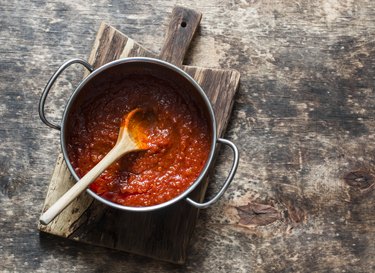
Tomato sauce is an acidic food, which means it's also a trigger for certain gastrointestinal conditions. Fortunately, it's possible to make low-acid pasta sauce by using fresh tomatoes and incorporating other low-acid vegetables. Adding baking soda or butter can also help reduce acidity.
Read more: The 10 Worst Foods for Acid Reflux
Video of the Day
Video of the Day
Low-Acid Tomato Sauce
Acidic foods can be particularly harmful to people who have GERD (gastroesophageal reflux disease), acid reflux and heartburn. According to the Mayo Clinic, these conditions are all closely related.
Harvard Health Publishing states that certain foods and beverages trigger GERD symptoms. These include acidic foods like citrus fruits, tomato sauces, garlic and onions. Unfortunately, these foods are all common ingredients in your average pasta sauce.
Clemson University's list of acidic and alkaline foods shows tomato paste and tomato puree as the most acidic tomato products. This means that prepared store-bought tomato sauces, crushed tomatoes and other preserved tomato products are all likely to make your spaghetti sauce acidic, and potentially trigger digestive symptoms.
While preserved and prepared tomato products are acidic foods, not all tomatoes are high in acid. Fresh tomatoes, like vine-ripened tomatoes, have less acidity than their processed counterparts. Making tomato sauce from scratch using fresh tomatoes may help you create a low-acid tomato sauce that can be used with pasta or any other meat or vegetable-based dish.
Low-Acid Pasta Sauce
If you want to make a low-acid pasta sauce for any reason, you have a variety of options. Using a fresh tomato sauce base is a good place to start. However, you may need to be careful about the other ingredients you use.
Pasta sauces often contain other fruits and vegetables, including olives, onions and artichokes. Fresh onions aren't particularly acidic foods. However, pickled onions are extremely acidic. Similarly, fresh artichokes aren't acidic, but canned ones can be.
Generally, it's best to use fresh ingredients to make low-acid tomato sauce. Vegetables like carrots, eggplant and spinach are easy to integrate and won't increase the acidity of your food.
If you find that your spaghetti sauce is acidic even after using fresh tomatoes and incorporating low-acid vegetables, you can also try adding certain ingredients to the sauce. Both baking soda and lactose-containing products can help reduce the acidity in tomato-based sauces.
Typically, you'll only need to add baking soda or butter to your tomato-based pasta sauce — not both. Around a quarter teaspoon of baking soda per cup of tomato sauce should help raise the pH and give you a lower-acid pasta sauce.
Butter, or any other fatty lactose product — like bechamel or half-and-half — can also help reduce the acidity of the tomato sauce. However, these are less likely to change the actual pH of the pasta sauce; instead, they're more likely to eliminate bitter and acidic flavors in your food.
If you have already added baking soda but feel that the flavor of your low-acid pasta sauce isn't quite right, you can also add a pinch or two of sugar. This won't change the pH further — so it won't have any benefit if you have GERD — but should round out the flavor, minimizing any residual acidic taste.
- Harvard Health Publishing: "GERD: Heartburn and More"
- Clemson University: "pH Values of Common Foods and Ingredients"
- Mayo Clinic: "Acid Reflux and Gerd: The Same Thing?"
- Cook's Illustrated: "Using Baking Soda to Tone Down Tomato Sauce"
- The Splendid Table: "Don't Eliminate Bitterness; Balance It With Fat and Salt"